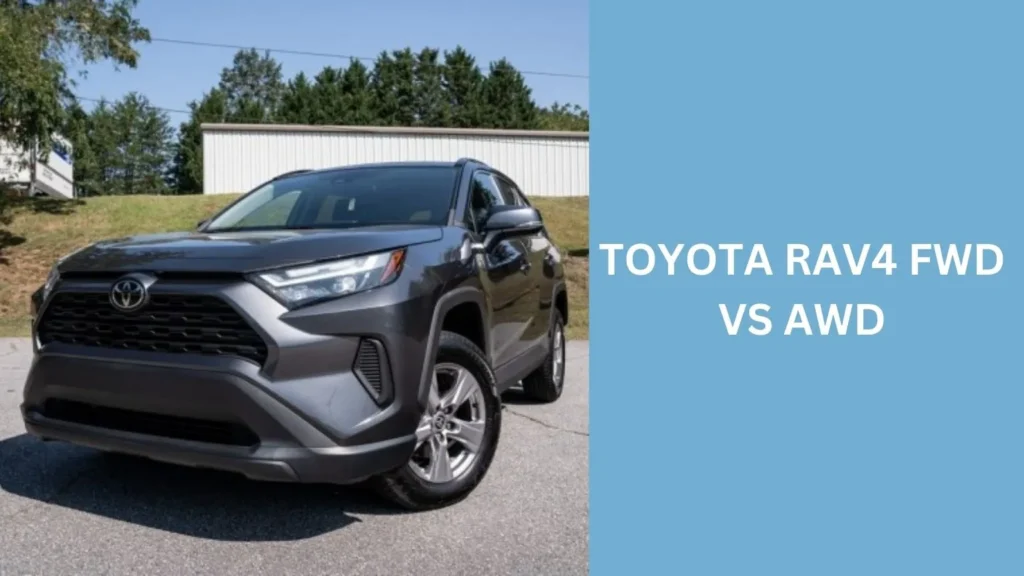Toyota RAV4 FWD VS AWD: Which One is Right for You?
When it comes to choosing a vehicle, understanding the differences between Front-Wheel Drive (FWD) and All-Wheel Drive (AWD) is crucial, especially with popular models like the Toyota RAV4.
Toyota RAV4 FWD VS AWD, In this article, we’ll break down the key differences between FWD and AWD in the RAV4, helping you make an informed decision based on your driving needs and lifestyle.

What is Front-Wheel Drive (FWD)?
Front-Wheel Drive (FWD) is a vehicle drivetrain configuration where the engine’s power is directed to the front wheels.
This design is commonly found in many modern cars and offers several advantages. Here’s a closer look at what FWD entails:
Understanding FWD in the Toyota RAV4
Front-Wheel Drive (FWD) is a configuration where the engine’s power is directed to the front wheels.
The Toyota RAV4 with FWD is designed for efficiency and is generally lighter, providing better fuel economy.
Benefits of FWD
- Fuel Efficiency: FWD models typically have better fuel economy because they are lighter and have fewer moving parts.
- Cost-Effectiveness: FWD vehicles are often less expensive than their AWD counterparts, making them a budget-friendly option.
- Predictable Handling: FWD systems provide stable handling on dry and wet roads, making them suitable for city driving.
What is All-Wheel Drive (AWD)?
All-Wheel Drive (AWD) is a vehicle drivetrain system that automatically distributes power to all four wheels, providing enhanced traction and stability.
This system is particularly useful for driving in various weather conditions and on different terrains. Here’s a detailed look at what AWD entails:
Understanding AWD in the Toyota RAV4
All-Wheel Drive (AWD) refers to a system that automatically distributes power to all four wheels.
The Toyota RAV4 with AWD is designed to enhance traction and stability, making it ideal for various driving conditions.
Benefits of AWD
- Enhanced Traction: AWD is perfect for driving in rain, snow, or off-road conditions, providing better grip and control.
- Versatile Performance: With AWD, you can confidently tackle a variety of terrains, from city streets to rugged trails.
- Increased Resale Value: AWD vehicles often have higher resale values due to their popularity and demand in adverse weather conditions.
Key Differences Between Toyota RAV4 FWD VS AWD
When considering the Toyota RAV4, understanding the key differences between Front-Wheel Drive (FWD) and All-Wheel Drive (AWD) can help you choose the right configuration for your driving needs.
Here’s a detailed comparison of the two systems:
Performance and Handling
When comparing the performance of the Toyota RAV4 FWD vs. AWD, it’s important to consider how each system handles different driving conditions.
- FWD Performance: The FWD RAV4 performs well on dry pavement and provides a smooth ride. It is more efficient, making it ideal for everyday commuting.
- AWD Performance: The AWD RAV4 excels in poor weather conditions, offering better control and traction. Whether you’re navigating snowy roads or uneven terrain, AWD provides peace of mind.
Fuel Economy
One of the most significant differences between FWD and AWD is fuel efficiency.
- FWD Fuel Economy: The FWD version typically offers better miles per gallon (MPG) ratings, which can lead to savings over time.
- AWD Fuel Economy: While AWD provides added traction, it often results in slightly lower fuel efficiency due to the added weight and complexity of the system.
Cost Considerations
When considering a purchase, the cost is always a factor.
- FWD Pricing: Generally, FWD models are less expensive, both in terms of the initial purchase price and long-term maintenance costs.
- AWD Pricing: AWD vehicles may come with a higher price tag, but the added safety and performance in adverse conditions can be worth the investment.
Which One Should You Choose?
Choosing between Front-Wheel Drive (FWD) and All-Wheel Drive (AWD) in the Toyota RAV4 depends on various factors, including your driving habits, climate, and lifestyle. Here’s a breakdown to help you make an informed decision:
Driving Habits
Your driving habits play a significant role in determining whether the FWD or AWD RAV4 is best for you.
- If You Primarily Drive in Urban Areas: If most of your driving is in the city or on well-maintained roads, the FWD RAV4 is likely sufficient for your needs.
- If You Face Harsh Weather Conditions: For those living in areas with heavy snow, rain, or off-road conditions, the AWD RAV4 offers better handling and safety.
Lifestyle and Activities
Consider your lifestyle and the activities you engage in:
- For Family and Daily Commutes: A FWD RAV4 may be perfect for family outings, daily commuting, and running errands.
- For Adventure Seekers: If you enjoy outdoor activities like hiking, camping, or skiing, the AWD RAV4 will give you the confidence to tackle various terrains.
People also ask
What is the difference between AWD and FWD RAV4?
The difference between AWD and FWD in the Toyota RAV4 lies in power distribution and performance:
FWD (Front-Wheel Drive): Power is directed to the front wheels only. It’s more fuel-efficient, lighter, and ideal for city driving and dry conditions.
AWD (All-Wheel Drive): Power is distributed to all four wheels, providing better traction and stability in adverse weather conditions, such as rain or snow, and off-road situations.
Is FWD RAV4 good in snow?
The FWD Toyota RAV4 can handle light snow and icy conditions reasonably well, thanks to its predictable handling and stability.
However, it may struggle in deeper snow or on slippery, unplowed roads compared to an AWD model.
For frequent driving in heavy snow or harsh winter conditions, an AWD RAV4 would be a better choice for improved traction and control.
Is the Toyota RAV4 front-wheel drive or all-wheel drive?
The Toyota RAV4 is available in both Front-Wheel Drive (FWD) and All-Wheel Drive (AWD) configurations. Buyers can choose between the two based on their driving needs and preferences.
Conclusion
Choosing between the Toyota RAV4 FWD VS AWD ultimately depends on your driving needs, lifestyle, and budget. If you prioritize fuel efficiency and city driving, FWD may be the way to go.
However, if you require enhanced traction for inclement weather or off-road adventures, the AWD version is worth the investment.
Take the time to test drive both options to see which feels right for you, and enjoy the journey ahead in your new Toyota RAV4!
I’m Micle R, and I’m thrilled to share my passion for the Toyota RAV4 with you. This site is dedicated to everything you need to know about this incredible vehicle, from detailed reviews and maintenance tips to the latest news and updates.





